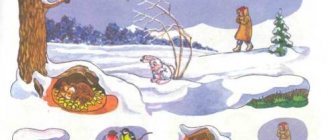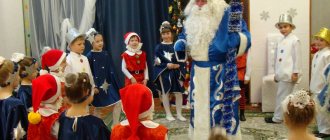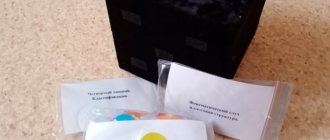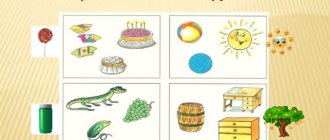How to learn the names of animals with your child
1) To begin with, an adult can simply tell the child about the habitats of animals, arrange the pictures correctly and name all the animals.
2) Then select any field and cards only related to it, invite the child to arrange them independently and name them.
3) Further complicate the classes, you can play lotto. The child himself chooses which animals he will collect, you take out the pictures from the bag, the child will name them and lay out the ones he needs on the field.
My son liked this game, he couldn’t even wait quietly for me to make it, he immediately joined the process. Look at the photo for yourself.
Good luck to you and your children in studying animals!
Educational game about animals - Who lives where?
LiveInternetLiveInternet
Quote from Tatyana57
Read in full In your quotation book or community!
SPEECH DEVELOPMENT. LEXICAL TOPIC “WILD BEASTS OF OUR FORESTS AND THEIR CHILDREN”
CHILDREN SHOULD KNOW THE NOUNS: bear, she-bear, bear cub, wolf, she-wolf, cub, hare, hare, little hare, fox, fox, fox, fox, hole, lair, squirrel, squirrel, hollow, moose, elk, calf, horns, hedgehog , hedgehog, hedgehog, wild boar, female boar, boar, badger, badger, little badger, forest, clearing, cheat, paw, wool, claws, nose, ears, hooves, tail. Muzzle, snout, mouth, animals, cubs, bushes, trees, mouse, lynx, raccoon, beaver, deer, marten, fangs, sable, mink, mole, den, connecting rod. ADJECTIVES: brown, clubfooted, cunning, predatory, gray, tireless, scary, thick (fur), red, wild, fluffy, dexterous, careful, fast, white, cowardly, long-eared, lop-eared, sensitive (ears), oblique, timid, velvet, prickly, wolf, striped. VERBS: wanders, climbs, roars, tears (bast), jumps, gallops, growls, grins. Hunts, escapes, howls, gnaws, digs, runs, “gave a go,” collects, stores, grunts, sniffs, sniffs, listens, hides, pricks, sneaks, sucks, lies down, falls. CHILDREN SHOULD BE ABLE TO NAME THE FAMILY: Bear, she-bear, little bear. Hare, hare, little bunny... SELECT NOUNS TO ADJECTIVES: Brown, club-footed, clumsy -... Gray, toothy, scary -... Cunning, fluffy, red-haired -... CALL MOM: The bear's cub, the fox's cub..., the bunny's... WHO HAS A VOICE : The fox yelps, the bear growls, the wolf howls... WHO LIVES WHERE: A fox lives in a hole. In the den - ... In the den - ... In the hollow - ... TO WHOM WE WILL GIVE WHAT: Meat - to the wolf, raspberries - ..., honey - ..., carrots - ..., nuts - ... SELECT NOUNS TO THE VERB: Hunts - ... Sneaks - ... Howls - ... Bites - ... Jumps - ... Tricks - ... Waddles - ... SELECT SIGNS: Wolf (which one?) -.... Fox (what?) - ... Hedgehog (what?) - ... SELECT ACTIONS: Bear (what is he doing?) - ... Fox (what is he doing?) - ... Hare (what is he doing?) - ... CORRECTLY ANSWERING THE QUESTIONS: Whose? WHOSE? WHOSE? WHOSE? Track - wolf, fox, hare... Ears - bear, hare, squirrel... Head - elk, hedgehog, wolf, fox... FORM NEW WORDS USING PRESIDENTS: Walks - moves, leaves, goes around, passes, enters, enters, descends, finds , leaves, approaches, reaches, comes, leaves, passes. COMPLETE A DESCRIPTIVE STORY ACCORDING TO PLAN. What is the name of? Where does he live? What kind of home does he have? What is the appearance? What habits? What does it eat? How does it get food? What are his enemies? How to defend yourself? What is the cub's name?
The fox is a predator. The fox mainly hunts mice, gophers, and less often hares. The fox cunningly catches hedgehogs. She rolls the hedgehog to the water, he straightens his spines in the water and swims to the shore. This is where the fox is waiting for him. The fox lives in a hole, and in the spring the fox gives birth to cubs. The squirrel is a rodent. She eats nuts, berries, mushrooms, and pine cones. The squirrel has sharp claws. This helps her quickly climb the tree. The fluffy tail serves as a parachute for the squirrel. A squirrel lives in a hollow and insulates its nest with down. In summer the squirrel is red, and in winter it is gray. In winter, the squirrel sleeps almost all the time and rarely looks out of the hollow. The squirrel is a thrifty housewife. She prepares nuts for the winter and dries mushrooms on tree branches. In the spring, squirrels give birth to squirrels. The wolf is a predatory animal. Wolves live in a pack. A pack is a wolf family. Wolves almost always hunt for sick, weak animals. Wolves hunt at night. Wolves live in a den to raise wolf cubs; wolf cubs appear in the spring. The bear is an omnivore. He loves to eat honey, berries, fish, ants, roots, but can also attack humans. The bear is clumsy in appearance, but easily climbs trees and runs quickly. The bear builds a den for himself from twigs, fallen trees, and moss. In winter, a mother bear gives birth to cubs. If a bear has accumulated little fat since the fall, it wakes up in the winter and walks through the forest hungry. For this the bear was nicknamed the connecting rod. The hare is a rodent. The hare feeds on grass, leaves, shrub bark, mushrooms, and roots. In winter, it chews the bark of trees. The hare is white in winter and gray in summer. This helps him hide from predators. Long, fast legs also save the hare from its enemies. The hare runs up the mountain at a run, and down the mountain somersaults. The hare lives under a bush in the summer, and digs a hole in the snow in the winter. In the spring, the hare gives birth to baby hares.
EXERCISE “GUESS AND TELL”. This beast lives in the forest, gnaws the bark of the trunks. In the summer in a gray fur coat, and in the winter in a white one. (Hare) - What does the hare eat in the spring? (grass, leaves). The owner of the forest wakes up in the spring, and in winter, to the howl of a blizzard, he sleeps in a snowy hut. (Bear) -What does a bear eat? (roots, grass, beetles, mice, hares). You and I recognize the animal by these two signs: He wears a gray fur coat in the winter, and a red fur coat in the summer. (Squirrel) - What does a squirrel feed on? (cones, nuts). All winter between the Christmas trees I slept through a bag of needles. “F-f-f-f—stop sleeping, It’s time to get up!” (Hedgehog) - What does a hedgehog eat? (bugs, worms, mice). Gray and toothy. Howls on a rainy day: “Uh-uh...” (Wolf) - What food does a wolf eat? (meat - catches mice, hares, sheep). Fluffy tail, golden fur, lives in the forest, steals chickens in the village. (Fox) - Who else does the fox catch? (mice, hares).
Summary of the didactic game “Wild and Domestic Animals.” (for the second younger group)
Summary of the didactic game “Wild and Domestic Animals” for the second junior group.
Educational goals:
Learn to listen carefully to the teacher and answer questions. Educational goals:
Continue to introduce children to the classification of animals (wild, domestic). Strengthen the ability to compare, find similarities and differences.
Developmental goals:
Increase children's speech activity and develop visual perception.
Preliminary work:
Reading stories about animals, board games with domestic and wild animals. Didactic games “Remember and name”, “Guess who it is”, “Whose mother is this”, “Find commonality”.
Equipment:
Forest, house, demonstration material from the series domestic and wild animals, laptop.
Organizing time.
- Guys, today we will go to the forest. How can you get there? (Developmental dialogue).
— We will go to the forest by bus. To get on the bus we need tickets. But the tickets are not simple. Be very careful. (The teacher shows tickets - geometric figures cut out of colored paper of different colors. Children name the geometric figure, color and sit on chairs with geometric figures and colors matching the tickets). Everyone sat down, let's go! (sound of a bus).
Main part.
- So we arrived in the forest. (The sound of the forest. Children go to a rug, a forest clearing, and sit on small pillows.)
-Who do you see in the clearing? (figures of wild and domestic animals in the clearing. Developmental dialogue).
-What's unusual here?
- Yes, children and pets live next to people, people feed them, build housing for them. A cow, a sheep, a horse and a goat came to a forest meadow to nibble grass and got lost.
-Who really lives in the forest?
-Yes, children, wild animals live in the forest. They find their own food, no one cares for them.
“These animals are lost and need to be escorted home.” Shall we help them?
(On one side of the room there is a toy model of a house and yard, and on the other there is a forest. Children name the animal and “show it off to their house”).
— Well done everyone, the animals are very grateful to you. And now it's time to return to our kindergarten. (The children get on the bus and leave to the sound of the bus.)
Bottom line.
- Well done boys. Tell me, please, where were we today? What were we doing? (Developmental dialogue).
MBDOU KINDERGARTEN No. 34 “RAINBOW” COMBINED TYPE EMR RT
Summary of the didactic game “Wild and Domestic Animals.”
(for the second younger group)
Prepared by:
Gayazova M.M.
Publication address:
Didactic materials on the topic: Autumn for kindergarten
Didactic material for consolidation on the lexical topic: “Autumn.”
Author: Meshcheryakova Svetlana Gennadievna, teacher - speech therapist MKOU Sh-I No. 8, Gremyachinsk, Perm region. Purpose: Generalization of students’ knowledge about the season - autumn. Objectives: Develop coherent speech, communication skills, auditory and visual attention, thinking; Improve the grammatical structure of speech; Cultivate curiosity. Description: It is known that good command of speech plays a significant role not only in everyday life, but also in a person’s professional activity. A person who is an interesting conversationalist and can effectively and clearly express his thoughts makes a more pleasant impression on others. Good command of your native language and speech is an art that needs to be learned. Why is it necessary to develop oral speech? - Be able to communicate with different people in different situations - Express your thoughts and feelings - Speak beautifully, correctly and pleasantly for listeners. Speech serves as a source of knowledge about the world around us, a means of communication and mutual understanding. In this regard, children’s ability to use speech becomes important. Every child feels the need to communicate. The need for communication is one of the most important in human life. When entering into relationships with the world around us, we communicate information about ourselves, in return we receive information that interests us, analyze it and plan our activities based on this analysis. And, of course, children want to be understood. Children often have difficulty describing people, objects, and phenomena. Even despite a sufficient vocabulary, most children do not know how to speak correctly, it is difficult for them to formulate their thoughts, they cannot fully participate in a conversation or conduct a dialogue. The formation of coherent speech is the main task of speech education. Good speech is an important condition for the development of a child’s personality. A didactic game is an excellent learning and development tool used in mastering any program material. Specially selected games and exercises make it possible to have a beneficial effect on all components of speech. In the game, the child gets the opportunity to enrich and consolidate vocabulary, form grammatical categories, develop coherent speech, expand knowledge about the world around him, develop verbal creativity, and develop communication skills. The proposed tasks are aimed at consolidating material on the lexical topic: “Autumn”. This is a kind of homework that is interesting to do with children after a speech therapy session at home, during a walk. The material will be useful to educators, primary school teachers, parents, and speech therapists. Assignment:
“Read, add, make sentences.”
Assignment:
“Place the words in order, make the correct sentence.”
Boots, rubber boots, footwear.
(Rubber boots are shoes)
Assignment:
“Favorite poems”
Listen to the poem.
Find offers. Read it expressively. In order to let children feel the beauty of the poetic word, an adult himself must feel it and be able to convey it in his performance.
You cannot read the work monotonously, inexpressively. Autumn.
The lingonberries are ripening. The days have become colder, And the cry of birds only makes my heart sadder. Flocks of birds fly away, away across the blue sea. All the trees shine in a multi-colored dress. The sun laughs less often, There is no incense in the flowers. Soon Autumn will wake up and cry awake.
Autumn.
A golden leaf is already covering the wet ground in the forest... I boldly trample with my foot the outer beauty of the forest. My cheeks are burning from the cold: I love to run in the forest, Hear the branches crack, Rake up the leaves with my foot!.. (A. N. Maikov)
Assignment: Read the poem. Come up with a name.
Task:
“Let’s clarify the signs”
Tell us what is typical for each autumn month? How is autumn different from summer?
Coordination of adjectives with nouns:
Task: Select epithets for the words: sun, sky, day, weather, trees, grass, animals, birds, insects.
Task: Find antonyms for the words: warm - cold, cloudy day - sunny day, dry - wet, long - short. Assignment:
“Say a tongue twister.”
First, say the tongue twister out loud slowly twice. Now to myself several times - at first slowly, then faster and faster. Learn to quickly pronounce tongue twisters out loud.
“All the maples have become red, And not a single one is teasing: Since everyone is red anyway, Who cares!”
Assignment:
“Learning to answer questions”
Depending on what task you set for the child, this is the answer you require: complete or short.
After reading the text, the answers can be full and meaningful. The question must be constructed competently and clearly so that the child is not distracted by extraneous details. Listen to the story.
Tell me, what time of year are we talking about? Look at the pictures, which one matches the story? It is important that the text read by adults is an example of the correct literary construction of a sentence, that it is bright and expressive.
Autumn
Autumn comes after summer. Gradually the days become cloudier, the sun shines less and less. The sky is covered with gray clouds. It often rains – long, drizzling rains. The leaves on the trees turn yellow and fall off. A cold wind tears leaves from tree branches, and they fall to the ground, covering it with a golden carpet. The grass is withering. It's damp and slushy outside. The birds don't sing anymore. They hide from the rain, gather in flocks and fly far to warmer climes. You can’t go outside without an umbrella, you’ll get wet. And it’s cold without a jacket and boots.
Multi-colored boats.
I came to the pond.
How many colorful boats are on the pond today: yellow, red, orange! They all arrived here by air. A boat will arrive, land on the water and immediately set sail. Many more will arrive today, and tomorrow, and the day after tomorrow. And then the boats will run out. And the pond will freeze. (D.N. Kaigorodov) Tell me what kind of boats float on the pond. What time of year do these boats happen? Color this picture and make up a story based on it. Share your impressions of autumn. Ask, how do you feel about autumn? Start your story with these words: I love autumn because... I don’t like autumn because...
Make up a story according to plan: “Day of Knowledge!”
Assignment: “What autumn gave us.” Words are helpers: garden, fruits, vegetables, vegetable garden, harvesting, harvest, mushrooms, baskets, forest, collect, ripened, harvest.
Game: “What grows in the garden?” Remember what grows in the garden. What grows in the garden? Look at the pictures, first name all the vegetables, then all the berries and finally all the fruits. Answer the questions and explain why there are several correct answers to the same question.
Game: “I cook myself” Show and name the vegetables from which borscht soup is made, and fruits for compote. We will cook borscht from... We will cook compote from...
Game: “I come up with a color” The names of some colors come from the names of words - objects. Let's come up with flower names together. Salad (what color?) – lettuce. Lingonberry (what color?) – lingonberry. Beetroot (what color?) – beetroot. Walnut (what color?) – nut. Carrots (what color?) – carrot. Plum (what color?) – plum. Game: “What kinds of juices are there?” What are these juices called? Apple juice – apple juice. Grape juice – grape juice. Carrot juice – carrot juice. Tomato juice – tomato juice. Cucumber juice – cucumber juice. Plum juice – plum juice. Cabbage juice – cabbage juice. Potato juice – potato juice. Cranberry juice - ... Pear juice - ... Assignment:
“Remember the proverb.”
Read the proverbs and explain how you understand them.
There is no turn from autumn to summer. Summer with sheaves, autumn with pies. In autumn, a gray morning, a red day.
Game: “What’s extra” Listen and guess which of the listed items is extra. Give a clear, complete answer. Start with these words: “I think I’m superfluous...” Chanterelle, porcini mushroom, fly agaric, boletus. Apple, pear, lemon, tomato. Sparrow, swallow, stork, heron, wagtail. Umbrella, jacket, hat, gloves, scarf. Provided you practice regularly, the results will not be long in coming.
We recommend watching:
Scenario for autumn fun in kindergarten. Middle-senior group Poems on an autumn theme for children 5-7 years old Autumn riddles for children 4-5 years old in kindergarten with answers Autumn changes in nature for preschoolers
Similar articles:
Outdoor games for a walk in the younger group in the fall
Autumn festival in kindergarten. Scenario
Outdoor games for children of the preparatory group indoors
Morning exercises in the middle group. October
About the month of November for children








